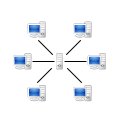What is a Network?
Network is a group of computers that can share informations through their interconnections. In other words, multiple computers that are connected together weather through wires or router that has the ability to share information. If you have two computers connected together that one can access information for the other, then you have a network. Within the I.T. field, these computers are know as nodes or hosts.
To understand Networking, you will need to become familiar with these three elements:
1. Transmission medium provides a path for electrical signals between devices
2. Network interface are devices that send and receive electrical signals.
3. Protocols are rules or standards that describe how hosts communicate and exchange data.
Become familiar with these terms, because it will be used by I.T. professionals in the field.
So how do networks save organization money?
Despite its cost and implementation, networks benefit organizations by helping it save money. Here are four examples:
1. First network helps consolidates storage. These storage are used to keep information (i.e. customer information, billing, track orders, employee payroll, etc...) that an organization needs to thrive.
2. Allows the ease of sharing peripheral devices like printers. By having networks, this allows for the company to connect multiple computers to one printer. This saves the company from having to purchase a printer for each computer. Though it may sound convenient for each computer to have it's own printer, it would be a waste of capital.
3. It will increase internal and external communications. Communications will help a company succeed and thrive among it's clients and employees.
4. Increase productivity and collaboration within the organization. The ability to email, call, share documents, and video conference increases work productivity for employees. Information, orders, assignments, and ideas are able to travel fast.
So what are the different types of Network?
There are different types of method that IT professional can install their computers. Let's identify them with their strengths and weaknesses.
1. Peer to Peer Network
 Image via Wikipedia
Image via Wikipedia2. Client/Server Network
What separates Client/Server Networks from P2PN is the ability to have a centralize authority. There are specialize computers such known as servers that help share files, printer managements, and data backup storage. If there is a problem with the printer, the network administrator would access the server to identify and resolve the problem. This network has the ability to manage a high volume of computers, because each computer is connected to this main server. The computers that are connected to the server are known as clients and the specialized computer that is the central authority is called the server.
 Image via Wikipedia
Image via WikipediaLet's Wrap it Up
A network is simply a bunch of computers connected together to share and access information. Networks save company money. There are two types of networks that exist, Peer to Peer and Client/Server Network. Peer to Peer is easy to maintain and implement. It does not work well if the there are many computers connected. Client/Server is the preferred network. The most expensive computer that is specialized (i.e. customized) is known and the server. The server acts as the boss computer. All the other computers that are connected to the server are known as clients. These computers are less expensive and cheap. If you have any thoughts or questions, leave them in the comment section or email me at thesoletech@gmail.com. Thanks.

No comments:
Post a Comment